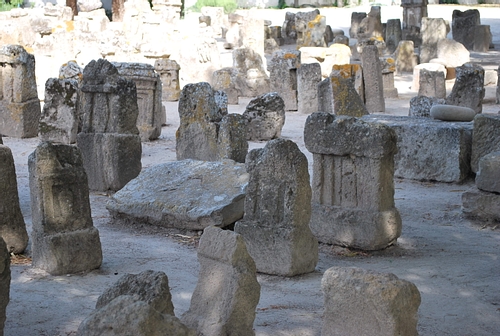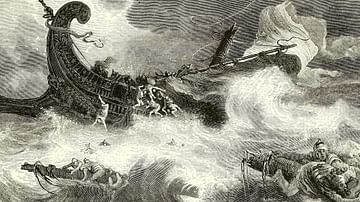
The Tophet (also topheth) was a sacred precinct usually located outside cities where sacrifices and burials were made, especially of young children, in rituals of the Phoenician and then Carthaginian religion. The tophet is the most evident cultural export from Phoenician cities to their colonies throughout the Mediterranean and they have been a valuable source of information on burial practices and even Mediterranean trade via the habit of using imported pottery as funerary urns to store the ashes of the deceased.
Function of the Tophet
One of the rituals of the Phoenician religion was to sacrifice humans, especially children, according to ancient sources. The victims were killed by fire, although it is not clear precisely how. According to the ancient historians Clitarch and Diodorus, a hearth was set before a bronze statue of the god Baal (or El) who had outstretched arms on which the victim was placed before falling into the fire. They also mention the victims wearing a smiling mask to hide their tears from the god to whom they were being offered. The victim's ashes were then placed in an urn and buried in tombs placed within a dedicated sacred open space surrounded by walls, the tophet.
Tophets are generally located outside the city proper and usually to the north. The tophet at Carthage has a shrine area with an altar where the sacrifices were made. After the ceremony the ashes of the burnt offering were placed within a vessel. Stones were then placed on top of the funerary urns to seal them and placed within the tophet, sometimes within shaft tombs. From the 6th century BCE, stelae were dedicated to Baal or Tanit and placed on top of the urns instead of stones. Many stelae have an inscription which describes a human blood sacrifice or the substitution of a sheep for a child. The urns themselves were often recycled pots and jars from as far afield as Corinth and Egypt and so provide an interesting and valuable record of Phoenician trade.
Geographical Spread of the Tophet
Although there is no archaeological evidence from Phoenicia itself of tophets, their presence in so many of its colonies across the Mediterranean attests that this cultural practice almost certainly did come from the home Phoenician cities such as Tyre, Sidon, and Byblos. One of the nearest tophets to Phoenician territory was at Tell Sukas on the Syrian coast, which dates to the 13th-12th century BCE. Regarding colonies, at Motya (off the coast of Sicily) the tophet there was first used from the mid-7th century BCE. There are also tophets at Sulcis, Bithia, Tharros, and Nora on the island of Sardinia. The most famous tophet is at Carthage, also known as the 'precinct of Tanit' and located to the south of the city at Salammbo. It was first used in the 8th century BCE and continuously thereafter until the fall of Carthage in the Punic Wars. At its largest extent it covered 6,000 square meters and has nine descending levels.
Child Sacrifice
Western Classical writers, describing little-understood eastern practices, gleefully recounted tales of child sacrifice holocausts, which gave the Phoenicians a blood-thirsty reputation throughout antiquity. Roman writers, eager to show that the defeated Carthaginians were barbaric, also exaggerated their Phoenician-inspired cults to better illustrate the virtue of Rome in defeating such a despicable foe. The Bible, too, describes these bloody practices (molk) in honour of the god Baal (II Kings 23:10, Exodus 22:29-30 and Jeremiah 7:30-31) locating them near Jerusalem in the valley of Ben Hinnom, literally, a site of slaughter, and stating they were of Phoenician origin. Whether the Phoenicians deserved their reputation as terrible baby-killers has only relatively recently been addressed by modern scholarship.
Firstly, it should be remembered that human sacrifice was carried out in most ancient cultures and is frequently referenced in ancient literature. In the Old Testament Abraham tries to sacrifice his own son Isaac (Genesis 22:1-2), in texts from Ugarit there is mention of sacrificing the first-born in times of great peril, and in Homer's Iliad King Agamemnon is called upon to sacrifice his daughter Iphigenia so that the Greek fleet may sail to Troy and reclaim Helen.
Secondly, the scale of human sacrifice carried out by the Phoenicians is difficult to determine but is unlikely to have been performed with any great regularity; no society can, after all, sustain a regular culling of its own population. All of the literary references to human sacrifice suggest that it was necessary only in times of great danger to the state such as wars, plagues, and natural disasters, and was not an everyday practice. Even in Phoenician mythology where the god El sacrifices his son Ieud it is to save his country from collapse. In another example, Diodorus describes the Carthaginian general Hamilcar sacrificing a child during the siege of Agrigento in the 5th century BCE when the defenders were suffering from a fatal outbreak of disease. Further, human sacrifices in ancient sources are almost always the children of rulers and the ruling class, as the gods, apparently, were not to be moved by the sacrifice of the common people.
Thirdly, and most importantly, the very fact that children were sacrificed at all is by no means as certain as ancient sources would have us believe. Whilst the archaeological record has revealed a huge number of funerary urns at tophets, over 20,000 at Carthage alone, and the majority contain the burnt remains of children, this does not necessarily indicate the children were sacrificed.
Archaeological Evidence
Analysis of remains within the tophet at Carthage reveals that internment of urns was regular and individual, i.e. not en masse. From the 7th to 6th centuries BCE the deceased were newborn babies while those dating from the 4th century BCE were mostly up to 3 years old. There are also, right from the beginning of the tophet, burnt remains of animals, and these account for 30% of the remains from the early period. From the 4th century BCE animal remains account for only 10% of the total. In both periods there are examples of urns with a mix of human and animal remains. Analysis also reveals that, overall, 80% of the human remains are from newborn babies or foetuses. This compares to findings at Tharros where 98% of the remains were from babies younger than three months old. The exact cause of death is not possible to determine but historian M. E. Aubet concludes the following,
...everything points to them dying of natural causes, at birth or a few weeks later. Although human sacrifice may have been practised, the high proportion of newborn babies in the tophets shows that these enclosures served as burial places for children who died at birth or had not reached the age of two. (252)
Further, 'The absence of tombs containing the newborn in the Phoenicio-Punic necropolises of the central Mediterranean would confirm that children were not buried next to adults, but in the tophet.' (253).
Conclusion
In conclusion, it seems that the reputation of the Phoenicians, and then the Carthaginians after them, as blood-thirsty child murderers lacks substantial physical evidence to support it. That child sacrifice did occur, as it did in other ancient religions, seems without doubt. However, the position that this was done only in times of great social stress and that the tophet is actually a sacred place for other types of sacrifice and a burial place for children who died a natural death has much to support it.











